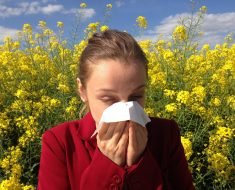According to the Centers for Disease Control and Prevention (CDC), 1 in 3 adults will develop shingles at some point during their lives. Shingles, or herpes zoster, is caused by the varicella-zoster virus, which is the same virus that causes chickenpox — so anyone who has previously had chickenpox can develop shingles.
Once someone has had chicken pox, the virus stays in their body, hidden in the nerve cells but does not usually cause further symptoms. Sometimes, however, the virus becomes re-activated, and the infection returns as shingles, not chickenpox.
What causes shingles on the face and eyes?

The location of the shingles rash depends on which nerves the virus has infected.
Shingles symptoms appear on the face when the chickenpox virus infects the facial nerves.
When shingles affects the eyes, the condition is medically referred to as herpes zoster ophthalmicus.
Doctors do not know why some people who have had chickenpox get shingles and others do not.
People with weak immune systems — including older people, people with HIV, people with AIDS, and people taking drugs that weaken the immune system — are more vulnerable to shingles.
Anyone of any age can, however, develop shingles on the face.
Shingles vs. other skin conditions
Shingles is different from other conditions in several ways:
- People may experience pain, including burning, tingling, or electrical sensations on their skin for 1 to 2 days before the rash develops.
- The shingles rash looks like a group of small blisters or lesions.
- The rash usually develops in one area, not as patches of blisters in different areas on the face.
- Shingles usually affects just one side of the face.
- Makeup, sun exposure, or an allergy do not trigger shingles.
- Shingles will not spread from one area of the body through contact, unlike some other rashes.
- Some people develop more lesions after the initial outbreak. These blisters might be near the location of the first rash, or somewhere else.
- The rash begins as sore blisters that may then crack, bleed, and scab over.
- Shingles lasts 1 to 2 weeks.
- Shingles sometimes causes other symptoms, such as a fever, headache, muscle aches, and stomach pain or vomiting.
- Only people who have previously had chickenpox can get shingles.

The most common complication of shingles is called postherpetic neuralgia (PHN).
PHN is damage to the nerves that can cause tingling, burning, pain, and other symptoms for months or years after the infection. Some people experience constant pain, while the pain comes and goes for others.
Complications from shingles are more common in people who have a weak immune system or a chronic medical condition, such as diabetes, HIV, and AIDS.
Shingles can, rarely, cause severe complications including:
- blindness and eye damage if shingles infects the eyes
- hearing loss
- brain inflammation
- pneumonia
Untreated or poorly managed shingles complications can be fatal. However, the death rate for shingles is low. A 2012 study estimates that shingles is an underlying cause of 78 deaths each year in the United States.
Diagnosing shingles
A doctor can usually diagnose shingles with a clinical exam. A doctor may take a sample of the skin for testing if it is unclear what is causing the rash. The test that assesses skin for shingles will, however, also give a positive result if a person has another herpes virus.
People who have shingles in or around the eyes should see an ophthalmologist because shingles around the eyes can cause eye problems, including glaucoma.

Shingles is not contagious. However, people who have never had chickenpox or are unvaccinated can contract the virus and develop chickenpox if exposed to an open sore.
Some ways to prevent developing shingles include:
- Getting vaccinated for chickenpox.
- Having the shingles vaccine after a shingles outbreak, or if a doctor suggests doing so. Older adults and people with weak immune systems may need the shingles vaccine.
- Managing and treating any existing conditions can prevent serious complications associated with shingles, and also reduce the risk of developing shingles.
Takeaway
Shingles can be intensely painful and may cause embarrassment when the rash is visible on someone’s face.
For most people, however, shingles is temporary and goes away on its own. People who think they might have shingles should see a doctor immediately.
Proper treatment can prevent the symptoms from getting worse and prevent against scarring and damage to the face.
Source: Read Full Article





